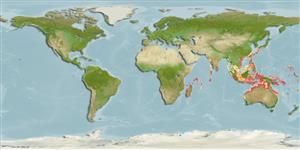Environment: milieu / climate zone / depth range / distribution range
Ecologie
marien rifbewoner; diepte 5 - 40 m (Ref. 90102). Tropical
Indo-West Pacific: Madagascar to Indonesia and Australia (Ref. 2334, 3131).
Grootte / Gewicht / Leeftijd
Maturity: Lm ? range ? - ? cm
Max length : 65.0 cm SL mannelijk / geslacht onbekend; (Ref. 48637)
Dorsale stekels (totaal): 6 - 7; Dorsale zachte stralen (totaal): 28-31; Anale stekels 3; Anale zachte stralen: 19 - 23. Adults (above 40 cm) silvery, with dark bar through eye and another (faint) bar just behind head. Fins dusky. Small juveniles black, vertical white lines on body and fins. Subadults brown, with black bar from nape, over eye to chest and another black bar from dorsal-fin origin, over pectoral fins to pelvic fins, pectoral and pelvic fins dark brown or black. Body orbicular and strongly compressed, its depth more than twice length of head and 1.1 to 1.9 times in SL. Snout profile of large adults (above 40 cm) concave, with prominent bony swelling between eyes. Jaws with bands of slender, flattened, tricuspid teeth, the middle cusp 3 to 4 times longer than lateral cusps. Vomer with a band of strong teeth, no teeth on palatines. Five pores on each side of lower jaw. Preopercle smooth. Opercle without spines (Ref 43039).
Inhabits continental reefs (Ref. 9710). Adults usually moderately deep on open substrates with sparse reef or coral heads. A solitary species, but occasionally in pairs or small groups. Small juveniles also in deep water and the zebra-pattern serves well as camouflage when sheltering with crinoids (Ref. 48637). Juveniles in shore waters; adults in deeper water.
Levenscyclus en paargedrag
Maturiteit | Voortplanting | Paaien | Eieren | Fecunditeit | Larven
Sainsbury, K.J., P.J. Kailola and G.G. Leyland, 1985. Continental shelf fishes of the northern and north-western Australia. An illustrated guide. CSIRO Division of Fisheries Research; Clouston & Hall and Peter Pownall Fisheries Information Service, Canberra, Australia. 375 p. (Ref. 3131)
Status op de Rode Lijst van het IUCN (Ref. 130435)
Gevaar voor de mens
Harmless
Gebruik door de mens
Aquarium: Commercieel
Meer informatie
Lokale namenSynoniemenMetabolismePredatorenEcotoxicologieVoortplantingMaturiteitPaaienPaaiaggregatiesFecunditeitEierenOntwikkeling van de eieren
ReferentiesAquacultuurAquacultuurprofielKweeklijnenGeneticaElectrophoresesErfelijkheidZiektesVerwerkingNutrientsMassaconversie
Tools
Speciale rapporten
Download XML
Internetbronnen
Estimates based on models
Preferred temperature (Ref.
123201): 25.1 - 29, mean 27.9 °C (based on 558 cells).
Fylogenetische diversiteitsindex (Ref.
82804): PD
50 = 0.5313 [Uniqueness, from 0.5 = low to 2.0 = high].
Bayesian length-weight: a=0.02692 (0.01137 - 0.06373), b=2.94 (2.74 - 3.14), in cm total length, based on LWR estimates for this (Sub)family-body shape (Ref.
93245).
Trofisch niveau (Ref.
69278): 3.5 ±0.37 se; based on food items.
Weerstandsvermogen (Ref.
120179): laag, minimale populatieverdubbelingstijd 4,5-14 jaar (Preliminary K or Fecundity.).
Fishing Vulnerability (Ref.
59153): Moderate to high vulnerability (52 of 100).
Nutrients (Ref.
124155): Calcium = 31.7 [16.8, 52.8] mg/100g; Iron = 0.472 [0.288, 0.735] mg/100g; Protein = 18.8 [17.6, 19.9] %; Omega3 = 0.0935 [, ] g/100g; Selenium = 36.6 [20.8, 64.8] μg/100g; VitaminA = 45.6 [13.6, 147.6] μg/100g; Zinc = 0.924 [0.657, 1.303] mg/100g (wet weight);
